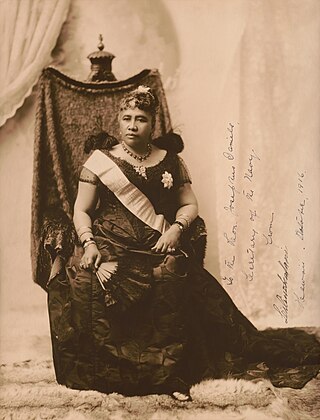
Liliʻuokalani was the only queen regnant and the last sovereign monarch of the Hawaiian Kingdom, ruling from January 29, 1891, until the overthrow of the Hawaiian Kingdom on January 17, 1893. The composer of "Aloha ʻOe" and numerous other works, she wrote her autobiography Hawaiʻi's Story by Hawaiʻi's Queen during her imprisonment following the overthrow.
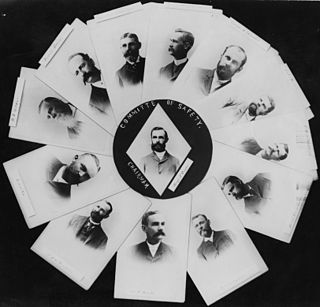
The Committee of Safety, formally the Citizen's Committee of Public Safety, was a 13-member group of the Annexation Club. The group was composed of mostly Hawaiian subjects of American descent and American citizens who were members of the Missionary Party, as well as some foreign residents in the Kingdom of Hawaiʻi. The group planned and carried out the overthrow of the Kingdom of Hawaiʻi on January 17, 1893. The goal of this group was to achieve annexation of Hawaiʻi by the United States. The new independent Republic of Hawaiʻi government was thwarted in this goal by the administration of President Grover Cleveland, and it was not until 1898 that the United States Congress approved a joint resolution of annexation creating the U.S. Territory of Hawaiʻi.
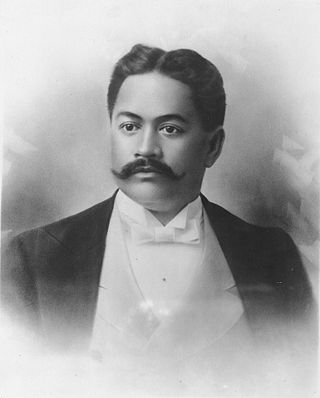
David Laʻamea Kahalepouli Kinoiki Kawānanakoa was a prince of the Hawaiian Kingdom and founder of the House of Kawānanakoa. Born into Hawaiian nobility, Kawānanakoa grew up the royal court of his uncle King Kalākaua and aunt Queen Kapiʻolani who adopted him and his brothers after the death of their parents. On multiple occasions, he and his brothers were considered as candidates for the line of succession to the Hawaiian throne after their cousin Princess Kaʻiulani but were never constitutionally proclaimed. He was sent to be educated abroad in the United States and the United Kingdom where he pioneered the sport of surfing. After his education abroad, he served as a political advisor to Kalākaua's successor, Queen Liliʻuokalani until the overthrow of the Hawaiian Kingdom in 1893. After Hawaii's annexation to the United States, he co-founded the Democratic Party of Hawaii.
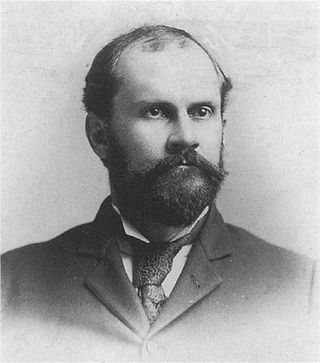
Lorrin Andrews Thurston was an American-Hawaiian lawyer, politician, and businessman. Thurston played a prominent role in the revolution that caused the Overthrow of the Hawaiian Kingdom that replaced Queen Liliʻuokalani with the Republic of Hawaii, guided by American ideas. He published the Pacific Commercial Advertiser, and owned other enterprises. From 1906 to 1916, he and his network lobbied with national politicians to create a national park to preserve the Hawaiian volcanoes.

Robert William Kalanihiapo Wilcox, nicknamed the Iron Duke of Hawaiʻi, was a Native Hawaiian whose father was an American and whose mother was Hawaiian. A revolutionary soldier and politician, he led uprisings against both the government of the Hawaiian Kingdom under King Kalākaua and the Republic of Hawaii under Sanford Dole, what are now known as the Wilcox rebellions. He was later elected the first delegate to the United States Congress for the Territory of Hawaii.

Paul Neumann was a lawyer, politician, and diplomat in California and the Kingdom of Hawaii.
The Wilcox Rebellions were an armed rebellion in 1888, a revolt in 1889, and a counter-revolution in 1895, led by Robert William Wilcox against the promulgation of the Bayonet Constitution in 1888 and 1889, and against the overthrow of the monarchy in 1895. He was considered a royalist and dedicated to the monarchy of the Kingdom of Hawaii. Wilcox's revolts were part of the Hawaiian Rebellions.

The proposed 1893 Constitution of the Hawaiian Kingdom would have been a replacement of the Constitution of 1887, primarily based on the Constitution of 1864 put forth by Queen Lili'uokalani. While it never became anything more than a draft, the constitution had a profound impact on Hawaiʻi's history: it set off a chain of events that eventually resulted in the overthrow of the Hawaiian Kingdom.

The overthrow of the Hawaiian Kingdom was a coup d'état against Queen Liliʻuokalani, which took place on January 17, 1893, on the island of Oʻahu and led by the Committee of Safety, composed of seven foreign residents and six Hawaiian Kingdom subjects of American descent in Honolulu. The Committee prevailed upon American minister John L. Stevens to call in the U.S. Marines to protect the national interest of the United States of America. The insurgents established the Republic of Hawaii, but their ultimate goal was the annexation of the islands to the United States, which occurred in 1898.

The Hawaiian Kingdom, also known as Kingdom of Hawaiʻi, was a sovereign state located in the Hawaiian Islands which existed from 1795 to 1893. It was established during the late 18th century when Hawaiian chief Kamehameha I, from the island of Hawaii, conquered the islands of Oahu, Maui, Molokai, and Lanai, and unified them under one government. In 1810, the Hawaiian Islands were fully unified when the islands of Kauai and Niihau voluntarily joined the Hawaiian Kingdom. Two major dynastic families ruled the kingdom, the House of Kamehameha and the House of Kalākaua.

George Lycurgus (1858–1960) was a Greek American businessman who played an influential role in the early tourist industry of Hawaii. After Queen Lili`uokalani was overthrown in a coup by the Committee Of Safety, he ran afoul of the government of the Republic of Hawaii and was accused of treason. Later he was instrumental in the development of the Hawaiian Volcano Observatory and Hawaiʻi Volcanoes National Park.

The Hawaiian rebellions and revolutions took place in Hawaii between 1887 and 1895. Until annexation in 1898, Hawaii was an independent sovereign state, recognized by the United States, United Kingdom, France and Germany with exchange of ambassadors. However, there were several challenges to the reigning governments of the Kingdom and Republic of Hawaii during the 8+1⁄2-year (1887–1895) period.

The 1895 Wilcox rebellion, or the Counter-Revolution of 1895 was a brief war from January 6 to January 9, 1895, that consisted of three battles on the island of Oʻahu, Republic of Hawaii. It was the last major military operation by royalists who opposed the overthrow of the Kingdom of Hawaii.
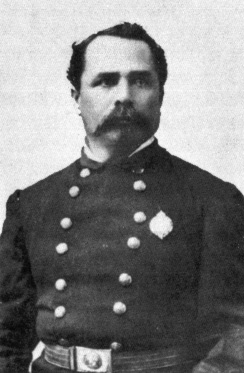
Charles Burnett "C.B." Wilson was a British and Tahitian superintendent of the water works, fire chief under King Kalākaua, and Marshal of the Kingdom under Queen Liliʻuokalani. Wilson was also the father of John H. Wilson.

Charles Thomas Gulick was a Kingdom of Hawaiʻi politician and one of the few members of the various missionary families of the time to side with the monarchy in the 1893 overthrow of the Kingdom of Hawaiʻi.
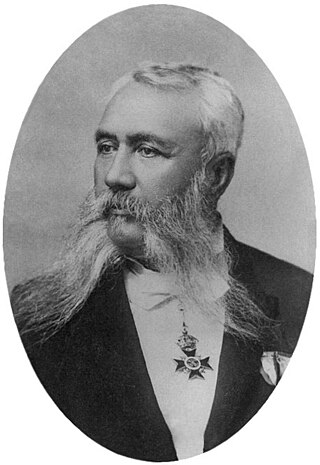
John Adams Kuakini Cummins was a member of the nobility of the Kingdom of Hawaii who became a wealthy businessman, and was involved in politics as the kingdom was overthrown.

Joseph Hewahewa Kaimihakulani Heleluhe was a member of the Hawaiian nobility who served as a retainer and private secretary of Queen Liliʻuokalani, the last monarch of the Kingdom of Hawaii, and accompanied her on her trips to the United States and Washington, D.C., from 1896 to 1900 to prevent the American annexation of Hawaii.

The 1881 world tour of King Kalākaua of the Hawaiian Kingdom was his attempt to save the Hawaiian culture and population from extinction by importing a labor force from Asia-Pacific nations. His efforts brought the small island nation to the attention of world leaders, but sparked rumors that the kingdom was for sale. Critics in Hawaii believed the labor negotiations were just an excuse to see the world. The 281-day trip gave Kalākaua the distinction of being the first monarch to circumnavigate the globe; his 1874 travels had made him the first reigning monarch to visit the United States and the first honoree of a state dinner at the White House.

Charles F. Creighton (1862–1907) was a member of Queen Liliʻuokalani's Cabinet Ministers as Attorney General of the Kingdom of Hawaii for the period November 1–8, 1892. Following the Overthrow of the Hawaiian Kingdom, he was arrested for his involvement in the 1895 Wilcox rebellion attempt to restore the monarchy. He accepted temporary exile to the United States to avoid a lengthy incarceration. His father Robert James Creighton had served as Kalākaua's Minister of Foreign Affairs.
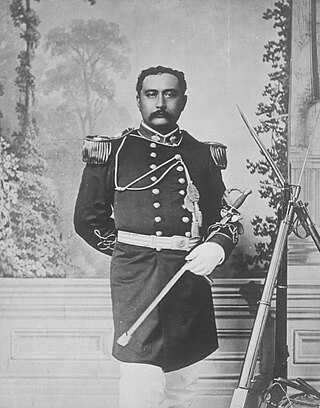
Samuel Nowlein was a Native Hawaiian Colonel who was a monarchist and known for organizing the 1895 Wilcox rebellion against the Republic of Hawaii before being caught and arrested during the rebellion.

















